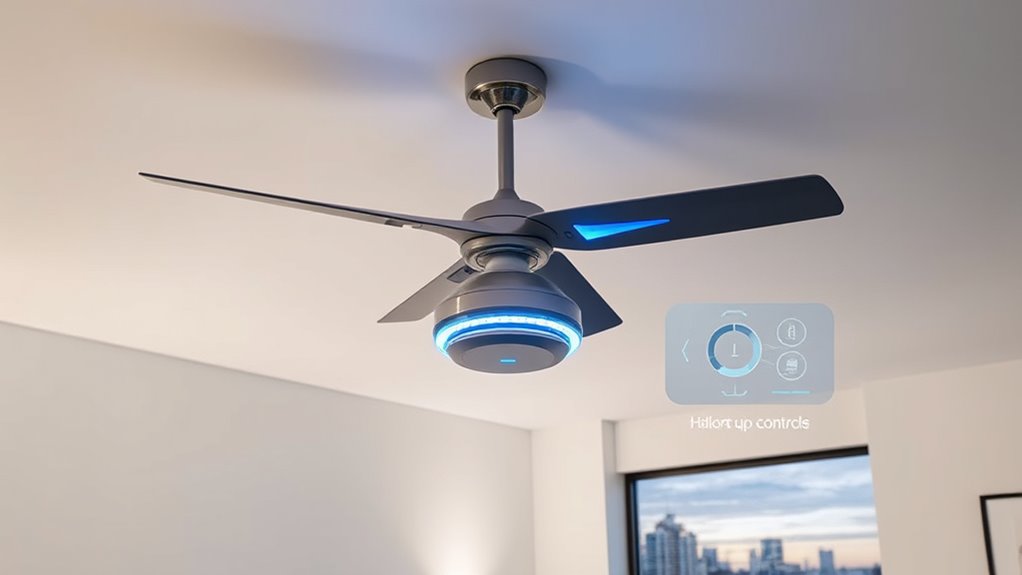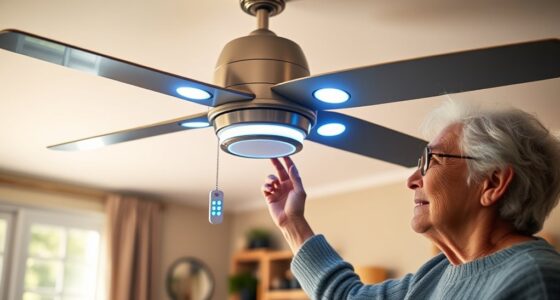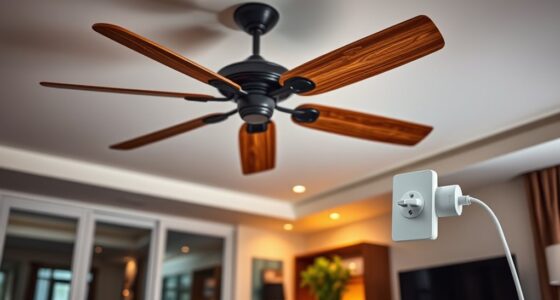By 2026, smart ceiling fans will fully integrate with IoT ecosystems, offering advanced sensors, AI-driven automation, and seamless voice and app control. They’ll optimize energy use through real-time feedback and adapt to your routines and environmental conditions. Enhanced materials will boost durability while self-cleaning features reduce maintenance. These intelligent fans will become central to your home’s energy management, providing personalized comfort with minimal effort—discover how these innovations will transform your living space.
Key Takeaways
- Smart ceiling fans will seamlessly integrate with home automation systems for remote control and voice command operation.
- Energy-efficient brushless DC motors and real-time sensors will optimize power consumption and airflow.
- Personalized user profiles and AI-driven automation will adapt fan settings to individual preferences and environmental changes.
- Advanced materials and self-cleaning surfaces will enhance durability, hygiene, and ease of maintenance.
- Fans will actively participate in overall household energy management, contributing to sustainability goals.

As smart technology continues to evolve, the ceiling fan industry is poised for substantial transformation by 2026, driven by advancements in IoT connectivity, energy efficiency, and user customization. You’ll notice that future fans won’t just be simple appliances but integrated components of your smart home ecosystem. IoT connectivity will enable seamless communication between your ceiling fan, voice assistants, and other smart devices, allowing you to control settings remotely and automate functions based on environmental data. Imagine walking into a room where the fan automatically adjusts its speed and oscillation based on occupancy, temperature, and humidity levels, all orchestrated through machine learning algorithms that predict your preferences over time.
By 2026, ceiling fans will seamlessly integrate with smart home systems, adapting automatically to your environment and preferences.
Energy efficiency will be at the core of these innovations, with next-generation fans utilizing cutting-edge motor technology, such as brushless DC motors, that consume considerably less power while delivering higher performance. You’ll benefit from built-in sensors that monitor airflow, temperature, and energy consumption, providing real-time feedback and optimization. These sensors will allow for precise control, reducing energy waste and lowering your utility bills. Additionally, smart fans will integrate with renewable energy sources and smart grids, enabling dynamic adjustments based on grid demands and energy availability, further reducing environmental impact.
User customization will become more sophisticated and intuitive. You won’t just set a basic on/off or speed level; instead, you’ll create detailed profiles that adapt to your daily routines. For example, your fan could learn your preferred airflow direction and speed during different times of the day or seasons, automatically adjusting without manual input. Voice commands and mobile apps will offer granular control, letting you fine-tune settings or schedule operation with ease. Moreover, with advanced sensors and AI, these fans will integrate with other smart home systems—like lighting, climate control, and security—to create holistic environmental management. For instance, your fan might work in tandem with your thermostat to maintain optimal comfort efficiently.
Furthermore, as a new trend in home automation, these fans will be capable of integrating with other energy management systems to optimize overall household efficiency and sustainability. Overall, technological convergence will push fan design toward more sustainable, adaptable, and intelligent solutions. Materials with better thermal properties and self-cleaning surfaces will extend durability and hygiene, while modular components will enable easier upgrades. Overall, by 2026, you’ll experience ceiling fans that are not just cooling devices but active participants in your smart, energy-conscious home, offering personalized comfort, reduced environmental impact, and effortless automation. This evolution will redefine what you expect from a ceiling fan, transforming it from a basic fixture into a sophisticated, intelligent component of your living space.
Frequently Asked Questions
How Will Smart Ceiling Fans Integrate With Future Home Automation Systems?
Smart ceiling fans will seamlessly integrate with future home automation systems through advanced IoT connectivity, allowing you to control them via centralized apps or voice assistants. They’ll adapt based on your habits, adjusting speed and airflow intelligently. Expect enhanced interoperability with other smart devices, energy-efficient algorithms, and real-time data sharing. This integration will make managing your home’s climate more intuitive, customizable, and energy-conscious, ultimately elevating your smart home experience.
Will Smart Ceiling Fans Become More Energy-Efficient by 2026?
Think of smart ceiling fans as the heart of your home’s energy system—by 2026, they’ll beat more efficiently. Advances in motor technology, AI-driven optimization, and eco-friendly materials will reduce power consumption markedly. You’ll see smarter sensors and adaptive algorithms that adjust airflow precisely when needed. This evolution symbolizes your commitment to sustainability, ensuring your home remains technologically advanced and environmentally responsible, all while lowering energy costs and minimizing your carbon footprint.
What Safety Features Will Be Standard in Future Smart Ceiling Fans?
Future smart ceiling fans will likely include advanced safety features like automatic shutoff if overheating occurs, integrated crash detection sensors, and enhanced blade guard designs. You can expect built-in smart diagnostics for real-time alerts, voice-activated emergency controls, and improved structural stability with vibration sensors. These innovations aim to diminish fire risks, prevent accidents, and guarantee reliable operation, providing you with safer, more secure smart home cooling solutions.
How Will AI Influence the Customization of Smart Ceiling Fan Settings?
AI will revolutionize how you customize smart ceiling fans by enabling real-time adjustments based on your preferences and environmental data. It will analyze factors like room temperature, humidity, and occupancy patterns to automatically optimize airflow and energy efficiency. You’ll experience personalized comfort with minimal manual input, as AI learns your habits over time, delivering seamless and intuitive control that adapts to your lifestyle, ensuring maximum comfort and savings.
Are There Any Upcoming Materials Expected to Enhance Fan Durability and Design?
Upcoming materials like advanced composites and thermally resistant polymers are expected to substantially boost fan durability and design flexibility. These materials will enable you to enjoy longer-lasting fans with sleeker, more innovative aesthetics. By integrating nanotechnology, manufacturers will improve heat dissipation and reduce wear, ensuring your smart ceiling fan stays reliable over time. Expect future designs to combine strength, lightweight construction, and aesthetic appeal, enhancing both functionality and style.
Conclusion
By 2026, smart ceiling fans will seamlessly integrate AI-driven climate control, enhancing energy efficiency and user comfort. Imagine a home where your fan auto-adjusts based on real-time occupancy and weather data, reducing energy bills while optimizing airflow. For instance, a smart fan in a smart home could learn your preferences and adapt automatically, showcasing the potential for predictive analytics and IoT connectivity. This evolution signals a future where intelligent, interconnected systems redefine home climate management.








